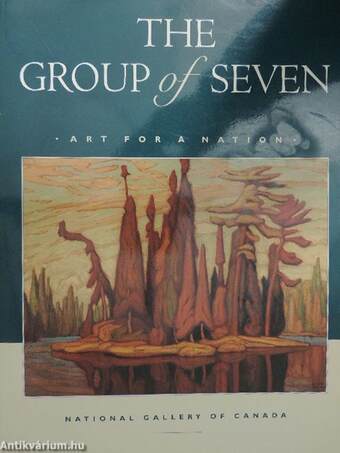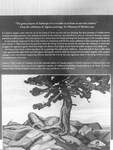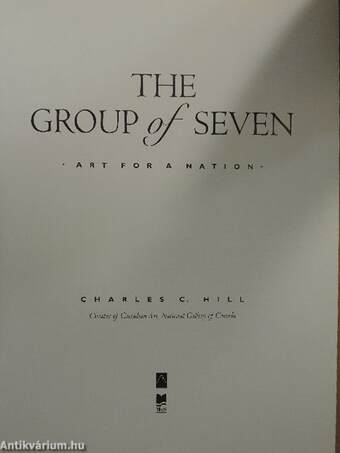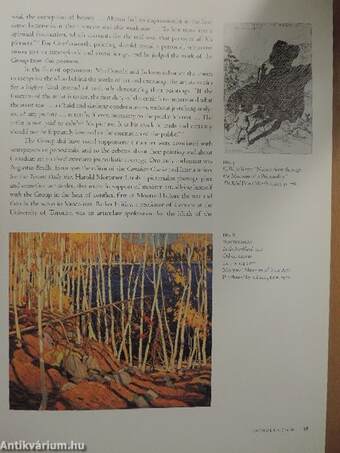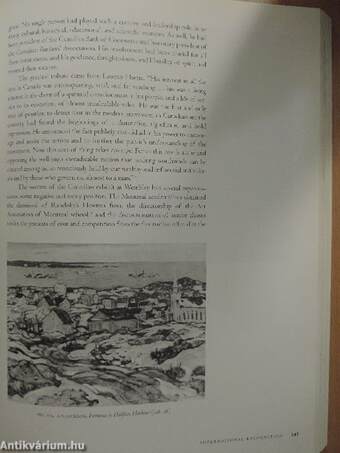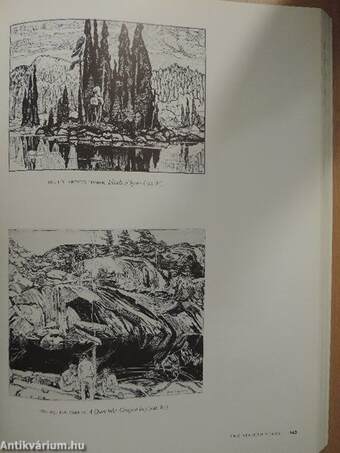1.067.663
kiadvánnyal nyújtjuk Magyarország legnagyobb antikvár könyv-kínálatát

VISSZA
A TETEJÉRE
JAVASLATOKÉszre-
vételek
The Group of Seven
Art for a Nation/National Gallery of Canada 13 October - 31 December 1995., Art Gallery of Ontario 17 February - 5 May 1996., Vancouver Art Gallery 19 June - 2 September 1996.
| Kiadó: | National Gallery of Canada |
|---|---|
| Kiadás helye: | Ottawa |
| Kiadás éve: | |
| Kötés típusa: | Fűzött papírkötés |
| Oldalszám: | 374 oldal |
| Sorozatcím: | |
| Kötetszám: | |
| Nyelv: | Angol |
| Méret: | 31 cm x 23 cm |
| ISBN: | 0-88884-645-2 |
| Megjegyzés: | Színes és fekete-fehér reprodukciókkal. Kiállítási katalógus. További grafikusok a katalógusban. |
naponta értesítjük a beérkező friss
kiadványokról
naponta értesítjük a beérkező friss
kiadványokról
Fülszöveg
The great purpose of landscape art is to make us at home in our own country. — From the exhibition of Algoma paintings, Art Museum of Toronto, 1919.
It is Kard to imagine a time when the art of the Group of Seven was new and even shocking. But their paintings of boulder-strewn riverbeds, hrooding mountain vistas, and pine trees bent by the wind were once described by critics as "travesties, abortions, sensuous and hideous malformations." Now, three-quarters of a century later, the Groups paintings have become a part of the Canadian identity.
In this landmark reappraisal of their work, written in conjunction with the first major exhibition of their paintings in twenty-five years, Charles C. Hill reconstructs the period in which the Group of Seven was förmed. He describes the conditions in which they struggled, the opposition against which they fought, the alliances they forged, and the battle for public acceptance they finally won.
The Group of Seven: Art for a Nation reproduces... Tovább
Fülszöveg
The great purpose of landscape art is to make us at home in our own country. — From the exhibition of Algoma paintings, Art Museum of Toronto, 1919.
It is Kard to imagine a time when the art of the Group of Seven was new and even shocking. But their paintings of boulder-strewn riverbeds, hrooding mountain vistas, and pine trees bent by the wind were once described by critics as "travesties, abortions, sensuous and hideous malformations." Now, three-quarters of a century later, the Groups paintings have become a part of the Canadian identity.
In this landmark reappraisal of their work, written in conjunction with the first major exhibition of their paintings in twenty-five years, Charles C. Hill reconstructs the period in which the Group of Seven was förmed. He describes the conditions in which they struggled, the opposition against which they fought, the alliances they forged, and the battle for public acceptance they finally won.
The Group of Seven: Art for a Nation reproduces all 179 paintings that make up the exhibition — more than half of them ín full colour — plus approximately eighty black-and-white figures showing the world in which the Group lived and worked. Together with complete catalogue entries and extensive supporting reference material, this is by far the most significant study of the Group of Seven to have been published in recent years.
Charles C. Hill, Curator of Canadian Art at the National Gallery of Canada, studied at McGill University in Montreal and at the University of Toronto. Since 1972, he has organized a number of exhibitions, including Canadian Painting in the Thirties, To Founda National Gallery: The Royal Canadian Academy of Arts, 1880-1913, and Morrice: A Gift to the Nation. Vissza
Témakörök
- Idegennyelv > Idegennyelvű könyvek > Angol > Művészetek > Festészet
- Idegennyelv > Idegennyelvű könyvek > Angol > Művészetek > Művészettörténet, általános
- Művészetek > Művészettörténet általános > Kontinensek művészete > Amerika
- Művészetek > Művészettörténet általános > Idegen nyelv > Angol
- Művészetek > Művészettörténet általános > Kiállítások, aukciók, katalógusok > Külföldi
- Művészetek > Festészet > Korszakok, stílusok > XX. század > Egyéb
- Művészetek > Festészet > Művésztelepek > Egyéb
- Művészetek > Festészet > Kiállítások, katalógusok > Külföldi
- Művészetek > Festészet > Idegen nyelv > Angol



